DDR3 Memory
DDR2 moved the "notch" to a different location so DDR2 could not be mounted in a DDR slot by accident, and vice versa. DDR3 provides a third notch configuration, designed to prevent mounting in older DDR and DDR2 slots.
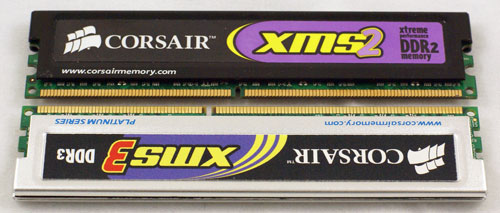
The first DDR3 memory to show up in our labs is from Wintec, who will market the DDR3 kit under their AmpX brand name.
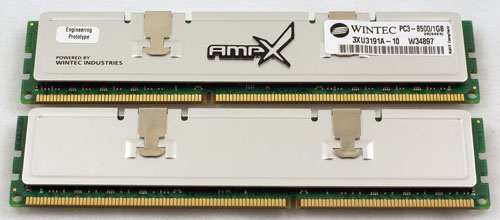
Corsair has also been at the forefront of DDR3 development and provided a Corsair 2 GB DDR3 kit for evaluation.

Both the Wintec and Corsair parts are rated at DDR3-1066 at 7-7-7-20 timings. Corsair also has a 1333 part that should be released in the next two weeks. We will follow up with that 1333 rated memory as soon as it is available.

DDR2 memory was also needed for the older P965 and new P35-based ASUS P5K Deluxe. Corsair Dominator DDR2-1111 was chosen for the wide range of available DDR2 memory speeds and the excellent timings available at DDR2-800 and DDR2-1067.
P35 Motherboards
Since the primary goal was to compare DDR2 and DDR3 performance it was important to find P35 motherboards that supported DDR2 and DDR3 in as similar a configuration as possible. ASUS will be marketing a pair of premium motherboards that differ only in the memory each motherboard supports.
The ASUS P5K3 Deluxe is powered by the Intel P35 chipset and fully supports DDR3 memory to an official DDR3-1333 speed.
The ASUS P5K Deluxe is based on the same P35 chipset but supports DDR2 memory. There are other minor differences in the two boards, but they are basically the same board supporting different memory types. This is exactly the configuration needed for our comparison.
For comparison to a current Intel chipset, the ASUS P5B Deluxe was used.
This excellent motherboard received the Gold Editors' Choice in the conclusion to our recent P965 motherboard roundup. It also supports a wide range of memory voltages and speeds which make it ideal for comparison testing to the P35 motherboards.
DDR2 moved the "notch" to a different location so DDR2 could not be mounted in a DDR slot by accident, and vice versa. DDR3 provides a third notch configuration, designed to prevent mounting in older DDR and DDR2 slots.

The first DDR3 memory to show up in our labs is from Wintec, who will market the DDR3 kit under their AmpX brand name.

Corsair has also been at the forefront of DDR3 development and provided a Corsair 2 GB DDR3 kit for evaluation.

Both the Wintec and Corsair parts are rated at DDR3-1066 at 7-7-7-20 timings. Corsair also has a 1333 part that should be released in the next two weeks. We will follow up with that 1333 rated memory as soon as it is available.

DDR2 memory was also needed for the older P965 and new P35-based ASUS P5K Deluxe. Corsair Dominator DDR2-1111 was chosen for the wide range of available DDR2 memory speeds and the excellent timings available at DDR2-800 and DDR2-1067.
P35 Motherboards
Since the primary goal was to compare DDR2 and DDR3 performance it was important to find P35 motherboards that supported DDR2 and DDR3 in as similar a configuration as possible. ASUS will be marketing a pair of premium motherboards that differ only in the memory each motherboard supports.
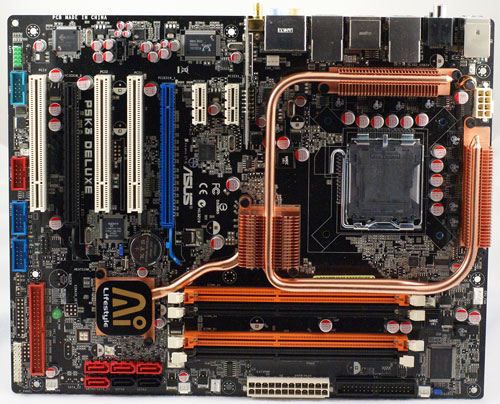 |
| Click to enlarge |
The ASUS P5K3 Deluxe is powered by the Intel P35 chipset and fully supports DDR3 memory to an official DDR3-1333 speed.
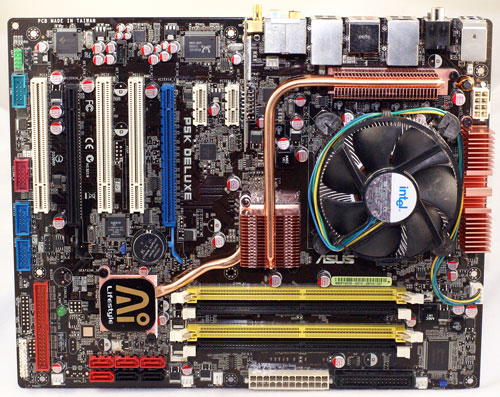 |
| Click to enlarge |
The ASUS P5K Deluxe is based on the same P35 chipset but supports DDR2 memory. There are other minor differences in the two boards, but they are basically the same board supporting different memory types. This is exactly the configuration needed for our comparison.
For comparison to a current Intel chipset, the ASUS P5B Deluxe was used.
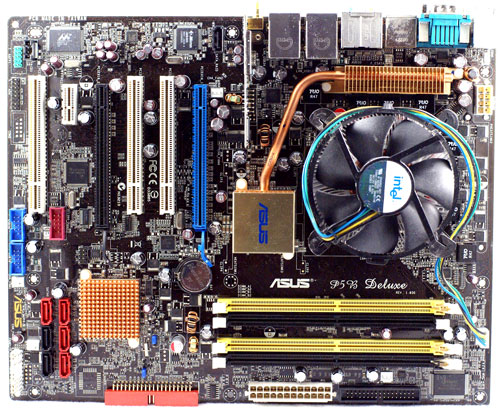 |
| Click to enlarge |
This excellent motherboard received the Gold Editors' Choice in the conclusion to our recent P965 motherboard roundup. It also supports a wide range of memory voltages and speeds which make it ideal for comparison testing to the P35 motherboards.










45 Comments
View All Comments
13Gigatons - Wednesday, May 16, 2007 - link
Suddenly it doesn't seem like a bad decision on AMD's part to hold off on their move to AM3 and DDR3 until 2008/2009. I really don't get why we need to change the memory technology so fast, with DDR2 finally dropping in price so fast.I'd rather have 4GB of DDR2 then 1GB of DDR3.
Sunrise089 - Wednesday, May 16, 2007 - link
Actually, a 2%-5% performance jump is very impressive from anything other than a CPU or GPU. Running a Raptor versus a 7200RPM drive, or a high-end motherboard versus a budget model, or a add-on sound card versus onboard audio all are choices many people make without any huge double digit performance gains in most applications.Thats said, the 2%-5% gain isn't from the memory standard (did you even read the article?) but from the new chipset. So these numbers have absolutely no bearing on AMD's choices.
Googer - Tuesday, May 15, 2007 - link
If you wanted to test bandwidth effects, why use a processor that is not very bandwidth dependant? Instead a bandwidth hungry LGA-775 Prescott should have been one the CPU's used in these DDR3 benchmarks. I'd like to see this article updated with a dual core netburst processor added.TA152H - Wednesday, May 16, 2007 - link
Are Prescotts even relevant anymore though? I mean, how many people are going to be perspecacious enough to buy a P35 based motherboard, and care about memory performance, and then go out and buy something as foul as a Prescott? It might make for an interesting data point, but it's a very little practical value.vailr - Tuesday, May 15, 2007 - link
Please include, in your forthcoming P35 board review: enabling SATA AHCI mode. Still remains puzzling, especially when a board uses a non-Raid Intel chipset, such as the ICH8. Gigabyte says on their web site, that on the GAS-965P-DS3, that AHCI should only be enabled when running Vista. Several other questions remain, such as: AHCI seems to work fine under WinXP when using the latest 1.17.17 JMicron drivers (single HD connected to a JMicron SATA port). Connecting the same HD to an Intel port, and AHCI won't work. Intel's offical AHCI drivers only seem to install when a Raid array is present.In summary: please include comments on any differences and/or improvements in AHCI support between the 965 v. P35 chipsets.
Comdrpopnfresh - Tuesday, May 15, 2007 - link
There was an article a few months ago saying that speed increases on ddr2 didn't really matter, the architecture for the memory was old enough that there was a decline in performance advantage as speeds increase. If ddr3 is basically the same as ddr2, wouldn't the same be expected? Does anyone have any idea when the timings will come down? The voltage is nothing to gawk at- it's the reason for the increased speed. On the gate level, the less space between high and low, he faster a gate can transition. I'm most interested to see ddr3 performance and bandwidth numbers w/ amd processors.R3MF - Tuesday, May 15, 2007 - link
i currently havean X2 system with PC3200 dual channel
and a C2D system with PC6400 dual channel
i definitely see a quad core 3.2GHz chip running PC12800 in my future.
hooray for technology!
DeepThought86 - Tuesday, May 15, 2007 - link
I wonder how long before Intel gets impatient and starts not-so-gently shoving DDR3 down people's throats long before the price or performance justify it?"Oh look, our chipsets for Nehalem don't support DDR2, woops you'll have to dump your DDR2 and get this spiffy new stuff. Look, it went from 2 to 3, it must be better!"
theprodigalrebel - Wednesday, May 16, 2007 - link
I remember reading an article somewhere where the interviewer asked an AMD person about Intel pushing for DDR3. The guy admitted that DDR3 is the way of the future - though not ready/relevant today - and only a company like Intel can drive that change.In his words, AMD's move to DDR2 came at the right time - in terms of price and advances in bandwidth/latency where DDR2 finally defeated the best DDR kits. He admitted that the move wouldn't have been possible unless Intel had moved the market in that direction over the past year or so.
Intel has driven changes from AGP to PCI-Express, IDE to SATA and DDR to DDR2. It seems forced at first - and it probably is - but you don't HAVE to be an early adopter. You had the 925 chipset introducing DDR2 and 915 boards supporting DDR. That is exactly what is happening here.
TA152H - Tuesday, May 15, 2007 - link
You need for Intel to push stuff down people's throats, or you'd never get these changes. No other company is in a position to, it's like IBM used to be almost 20 years ago.The price of the memory will go down as production goes up, which of course is driven by demand, which of course has to be driven by Intel. If not Intel, then who?
By offering a chipset that offers both, they are slowly starting the transition and the prices should get closer. At some point, supporting DDR2 is just a waste of chipset space and is costing people money that have no intention of ever using it, so you get rid of it. At that point it might cost a little more still, but that's the price you pay for transitioning to a better technology, and making that technology cost effective. I think they're extremely important to the industry for exactly that reason, not a malicious force.